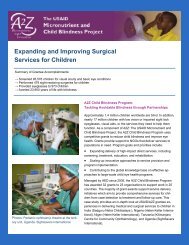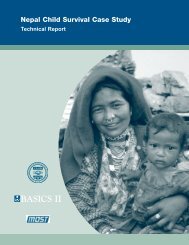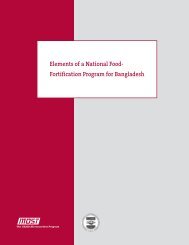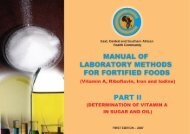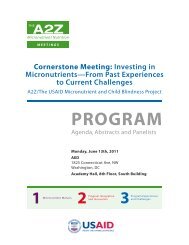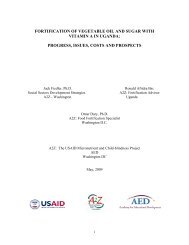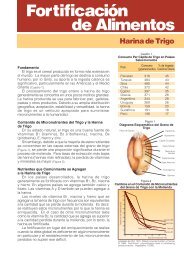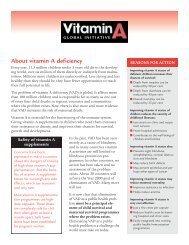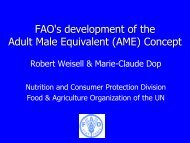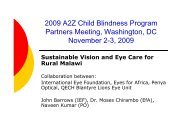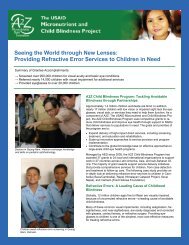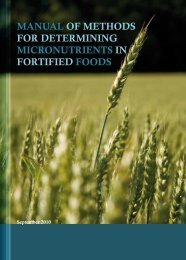Manual for External Monitoring of Fortified Maize Flour - A2Z: The ...
Manual for External Monitoring of Fortified Maize Flour - A2Z: The ...
Manual for External Monitoring of Fortified Maize Flour - A2Z: The ...
You also want an ePaper? Increase the reach of your titles
YUMPU automatically turns print PDFs into web optimized ePapers that Google loves.
ForewordOver the last five years, the East, Central and Southern African Health Community (ECSA-HC) has continued to undertake advocacyand technical assistance to assist member countries to embrace and scale up Food Fortification initiatives as a key strategy to reducemicronutrient malnutrition in the region.ECSA has been working with partners in direct response to resolutions <strong>of</strong> the Conference <strong>of</strong> Health Ministers to scale up Food Fortificationinitiatives as a critical plank in fighting the devastating effects <strong>of</strong> micronutrient malnutrition among populations <strong>of</strong> member states. ECSApartners in the Regional Food Fortification Initiative include the <strong>A2Z</strong> Project, USAID, UNICEF, Micronutrient Initiative (MI), and ICCIDD,among others.Part <strong>of</strong> the outcome <strong>of</strong> the intensified collaborative initiative, is a series <strong>of</strong> <strong>for</strong>tification guidelines developed to guide the Industry during the<strong>for</strong>tification process <strong>of</strong> staple foods and provide government food inspectors a reference point in en<strong>for</strong>cing the standards.Similarly, food control manuals have been developed <strong>for</strong> the Industry and the Government to provide technical reference resources thatcover the entire <strong>for</strong>tification process to ensure that the <strong>for</strong>tified foods are safe and adequately <strong>for</strong>tified with the required <strong>for</strong>tificants.This manual is part <strong>of</strong> a series <strong>of</strong> manuals on food <strong>for</strong>tification and is meant to directly contribute to the overall ef<strong>for</strong>t to strengthen food<strong>for</strong>tification in the region.It is our hope that the use <strong>of</strong> this manual will help strengthen food control activities in our countries in order to deliver safe and quality<strong>for</strong>tified foods to the ECSA population.Steven ShongweExecutive Secretaryi
AcknowledgementThis <strong>Manual</strong> has been developed by the ECSA Health Community Secretariat with technical and financial assistance from the Academy<strong>for</strong> Educational Development through <strong>A2Z</strong>: <strong>The</strong> USAID Micronutrient and Child Blindness Project (GHS-A-00-05-00012).<strong>The</strong> manual is as a result <strong>of</strong> joint work by distinguished food <strong>for</strong>tification experts in developing countries. During the drafting <strong>of</strong> thismanual, consultations with senior <strong>of</strong>ficers from food control departments <strong>of</strong> the ECSA member states were made and input incorporated.About the AuthorsPhillip Makhumula:A Malawian food <strong>for</strong>tification consultant with experience in Africa and Central Asia.Monica Guamuch:A Guatemalan food <strong>for</strong>tification consultant with experience in Latin American and the Caribbean.Margaret Mazhamo:A Food Control Manager with Experience in Fortification in Zambia.Dr. Omar Dary:<strong>The</strong> Food Fortification Specialist <strong>of</strong> <strong>A2Z</strong> / USAID Program <strong>of</strong> Micronutrients and Child Blindness.ECSA is deeply thankful to the above authors <strong>for</strong> preparing this manual.Disclaimer<strong>The</strong> content <strong>of</strong> this manual can be adapted to suit country specific contexts. In such a case, the content <strong>of</strong> the resulting document will bethe sole responsibility <strong>of</strong> the organization adapting the manual and will not represent the views <strong>of</strong> the authors and that <strong>of</strong> the ECSA-HC.<strong>The</strong> Use <strong>of</strong> the content <strong>of</strong> this manual should be duly acknowledged.ii
TABLE OF CONTENTSA. Planning inspection visits.....................................................................................................................................................................2B. Technical auditing and inspection visits ............................................................................................................................................4C. Inspection by corroborating trials .......................................................................................................................................................7LIST OF TABLES<strong>Fortified</strong> <strong>Maize</strong> <strong>Flour</strong> - Audits and Inspection-Table B-1 ......................................................................................................................10Briefing Sessions - Technical Audit and Inspection Visits ..........................................................................................................................10<strong>Fortified</strong> <strong>Maize</strong> <strong>Flour</strong> - Audits and Inspection-Table B-2 .......................................................................................................................11Checklist <strong>of</strong> Technical Audit and Inspection visit to maize mills ..................................................................................................................11<strong>Fortified</strong> <strong>Maize</strong> <strong>Flour</strong> - Audits and Inspection-Table B-3 ......................................................................................................................13Preliminary Report - Technical Audit and Inspection Visits ........................................................................................................................13iii
MANUAL FOR EXTERNAL MONITORING OF FORTIFIED MAIZE FLOUR(Technical Auditing and Inspection)Technical auditing and inspection activities are carried out at maize mills as part <strong>of</strong> the en<strong>for</strong>cement activities per<strong>for</strong>med by the governmentin order to ensure that <strong>for</strong>tified maize flour meets the nutrient quality and safety specifications established in regulations. During the technicalaudits, the per<strong>for</strong>mance <strong>of</strong> quality assurance and quality control activities conducted by the producer is examined. <strong>The</strong> con<strong>for</strong>mity <strong>of</strong> the<strong>for</strong>tified food with technical specifications is determined through sampling and chemical analysis <strong>of</strong> flour samples collected from the factory.Samples <strong>of</strong> premix are also taken to verify the validity <strong>of</strong> the Certificate <strong>of</strong> Analysis (COA) provided by the supplier.This manual presents steps <strong>for</strong> carrying out technical auditing and inspection in maize mills. <strong>The</strong> Food Control Authority in the country isresponsible <strong>for</strong> carrying out the auditing and inspection activities <strong>of</strong> <strong>for</strong>tified foods, in coordination with other government bodies involvedin the en<strong>for</strong>cement <strong>of</strong> food <strong>for</strong>tification regulations.Since technical audits are based on checking the producer’s records, the objectives which are measured by indicators and criteria <strong>of</strong>success are based on similar objectives used <strong>for</strong> the QA/QC system. <strong>The</strong> manual also describes the people responsible <strong>for</strong> each stage.As any en<strong>for</strong>cement procedure carried out by a government body, the warnings and legal actions to be taken when non-compliance occursshould be defined and applied where necessary.Results <strong>of</strong> auditing and inspection activities should be consolidated twice a year in order to determine the degree <strong>of</strong> success in fulfilling the<strong>for</strong>tification goals identify obstacles to overcome and propose actions to be taken. It is recommended that an annual report be prepared andpublished where data from this external monitoring is presented graphically to describe the status <strong>of</strong> the maize flour <strong>for</strong>tification programin the country, along with in<strong>for</strong>mation from other food control or surveillance activities.<strong>The</strong> sections included in this manual are:• Planning inspection visits• Technical auditing and inspection visits• Inspection by corroborating trials1 <strong>of</strong> 13
A. PLANNING INSPECTION VISITSI. Objectives and Accountability<strong>The</strong> purpose <strong>of</strong> planning inspection visits is to ensure that:• Resources to visit the maize mills at least two times a year are allocated.• Inspectors receive appropriate training on the <strong>for</strong>tification process and sampling in order to per<strong>for</strong>m the auditing and inspectionactivities.<strong>The</strong> supervisor <strong>of</strong> Food Control inspectors is responsible <strong>for</strong> achieving these objectives and submitting the monitoring plan to the Head<strong>of</strong> the Food Control Authority.II. Procedure<strong>The</strong> supervisor <strong>of</strong> inspectors shall per<strong>for</strong>m the following dutiesa. Plan, budget and schedule1. Based on the total number <strong>of</strong> maize mills that should be visited, plan at least two yearly visits to each mill.2. Estimate the financial resources that will be needed considering:• Personnel• Transportation and fuel• Approximate number <strong>of</strong> samples to be analyzed and cost• Consider other expenses such as approximate number <strong>of</strong> extra-visits3. Plan a training workshop <strong>for</strong> the inspectors regarding the <strong>for</strong>tification process in the maize mills, the Quality Assurance and Control (QA/QC) per<strong>for</strong>med by the mill, and auditing and sampling activities during the visits to factories.4. Provide a report to the Head <strong>of</strong> Food Control Authority on the plan, schedule and estimated budget to carry out the whole plan.2 <strong>of</strong> 13
. Defining actions to be taken5. Clearly define the actions to be taken when non-compliance is found during a visit. <strong>The</strong>se actions might include warnings and legalactions, which should be considered within the legal framework <strong>of</strong> the Food Control regulations. <strong>The</strong> following actions aresuggested:• When a minor non-compliance is found, technical advice should be provided to the production personnel on areas that needimprovement and follow up with more frequent visits.• When a major non-compliance is found during a visit, a letter should be sent to the factory stating the issues identified and the needto correct the issue(s). <strong>The</strong> food control authority should then conduct a comprehensive audit visit and submit immediately, clearlystated corrective actions specifying a time frame.During the next visit, they should assess implementation <strong>of</strong> corrective actions. <strong>The</strong> follow up visit, which may take place ahead <strong>of</strong>schedule if the identified limitations are considered serious.• If the factory is found to have not taken any action to solve the problem or if there is pro<strong>of</strong> that the noncompliance is intentional, actionshould be taken against the factory and this could vary from a written warning to legal action such as a fine.• If corrective measures are in process <strong>of</strong> being implemented, or new unrelated findings that require redress are identified, continueproviding technical support and conduct more frequent follow up visits.III. Records and Reporting<strong>The</strong> person in charge <strong>of</strong> the inspection visits should keep records <strong>of</strong> the plan, schedule and estimated budget. This in<strong>for</strong>mation has to bereported to the Head <strong>of</strong> the Food Control Authority.3 <strong>of</strong> 13
B. TECHNICAL AUDITING AND INSPECTION VISITSI. Objectives and Accountability<strong>The</strong> purpose <strong>of</strong> the technical auditing and inspections visits is to verify that the maize mill has implemented and continues to apply aprogram <strong>for</strong>:• Quality assurance <strong>of</strong> premix receipt, storage and distribution• Quality assurance <strong>of</strong> the maize flour <strong>for</strong>tification process• Quality control <strong>of</strong> the <strong>for</strong>tified maize flour<strong>The</strong> Inspector should visit the premises and plan to spend an hour or two to make detailed examination <strong>of</strong> processes and verifydocumentation. <strong>The</strong> visit should be made with the view to assist the factory per<strong>for</strong>m better and the frequency <strong>of</strong> the visits may be scaleddown or scaled up depending on the per<strong>for</strong>mance <strong>of</strong> the factory. Where possible, and when the <strong>for</strong>tification program is new, the visitsshould be done on a monthly basis and be scaled down depending on the success <strong>of</strong> the <strong>for</strong>tification in the factory. Once the operationis working smoothly, two visits per year may be sufficient.<strong>The</strong> people directly responsible <strong>for</strong> achieving these objectives are the Food Control Authority inspectors, who should pass on the results<strong>of</strong> the visits to their Supervisor. <strong>The</strong> Supervisor is responsible <strong>of</strong> preparing the reports to the maize mills and reporting every threemonths to the Head <strong>of</strong> the Food Control Authority and any other government body involved in the en<strong>for</strong>cement <strong>of</strong> <strong>for</strong>tified foods.II. Procedure (Food Inspectors)a. Opening session1. Start the visit with an opening session where the General Manager, Factory or Production Manager, Quality Assurance and Control4 <strong>of</strong> 13
Department Manager and Laboratory Manager are present. Explain briefly the purpose and approximate duration <strong>of</strong> the visit andexplain that this will be carried out through reviewing <strong>of</strong> written procedures, records, personnel interviews, observation <strong>of</strong> the <strong>for</strong>tificationprocess and taking some samples.Record names <strong>of</strong> attendants during the session in Table B-1.b. Technical audit2. Begin the technical audit with the aid <strong>of</strong> the checklist presented in Table B-2, section A. As the audit takes place, record any non-compliance found in Table B-2, section C.3. Also review the non-compliances found during the last visit and the recommendations made. Assess the corrective actions andrecord the findings in Table B-2, section B.c. Inspection4. At the end <strong>of</strong> the audit, take five samples <strong>for</strong> inspection by corroborating trials (refer to Section C –Inspection by CorroboratingTrials).5. Take a sample <strong>of</strong> the undiluted premix (50 g) currently used <strong>for</strong> <strong>for</strong>tification, from the original container <strong>of</strong> the supplier. Write down thetype <strong>of</strong> iron used in the premix as labeled on the box or the Fact Sheet, as well as in<strong>for</strong>mation <strong>of</strong> other nutrients. Use Table B-2, cellD.d. Preliminary report6. Plan to dedicate from 15 to 30 minutes to finish the preliminary report on the major findings during the visit. In the report, providecomments regarding the per<strong>for</strong>mance <strong>of</strong> the quality assurance and control procedures, opportunities <strong>for</strong> improvement and noncomplianceif any (use Table B-3).5 <strong>of</strong> 13
e. Closing session7. Finish the visit with a closing session to be attended by those present during the opening session. Check again in Table B-1 thenames <strong>of</strong> those attending. Explain the major findings as stated in the prepared preliminary report. If non-compliances are foundin<strong>for</strong>m the general management about the necessary actions to be taken.8. Leave a copy <strong>of</strong> the report with the Quality Assurance Manager.f. Samples transport9. Pack the samples in suitable tight containers, and transport the samples appropriately, protecting from exposure to heat, humidityand direct sun light.10. As soon as the inspectors arrive to their headquarters, they must give the samples to the Supervisor <strong>of</strong> Inspectors, who will in turnsend them to the Food Control National Laboratory.III. Records and reporting (Supervisor <strong>of</strong> Food Inspectors)1. Once results from the laboratory are received and analyzed by the Head <strong>of</strong> Inspectors, send a final report to the General Manager <strong>of</strong>the maize flour mill with some interpretation <strong>of</strong> results and suggestions <strong>for</strong> corrective action where necessary.2. If non-compliance is found, enclose a warning letter stating the points that shall be corrected be<strong>for</strong>e the next visit.6 <strong>of</strong> 13
C. INSPECTION BY CORROBORATING TRIALSI. Objectives and Accountability<strong>The</strong> purpose <strong>of</strong> the corroborating trials is to ensure that:• All flour samples (including single samples) contain added iron and vitamin A, which are used as the micronutrient “indicators”:• 80% <strong>of</strong> them (composite samples) satisfy regulatory requirements with an average close to the specified factory addition level, <strong>for</strong>example:• All premix samples comply with the specifications established in the standard <strong>for</strong> the premix Inspectors are directly responsible <strong>of</strong>taking the samples at the maize mills whereas the National Food Control Laboratory is responsible <strong>for</strong> analyzing them. <strong>The</strong> Supervisor<strong>of</strong> the food inspectors coordinates the activities, from checking the records <strong>of</strong> the auditing visits, receiving and analyzing the laboratoryresults as well as preparing and sending the reports. <strong>The</strong> same <strong>of</strong>ficer should prepare a consolidated report every three monthsabout the activities accomplished and actions taken, and send it to the Head <strong>of</strong> the Food Control Authority.II. Procedure <strong>for</strong> Sampling (by Food Control Inspectors)a. Fortification Premix1. Take a 50-g sample <strong>of</strong> the premix that is being used <strong>for</strong> <strong>for</strong>tification at the factory during the time <strong>of</strong> inspection. Label it with the name<strong>of</strong> the mill, name <strong>of</strong> the manufacturer, vitamin A and iron content indicated, and date <strong>of</strong> sample collection.b. Daily composite samples2. Be<strong>for</strong>e the inspection visit ends, go to the laboratory and check that “daily composite samples” <strong>for</strong> the last 30 working days areappropriately stored.3. Choose three daily composite samples at random. In Table B-2, write down the production date, estimated iron level, and any otherin<strong>for</strong>mation provided on the sample identification.7 <strong>of</strong> 13
c. Samples from production or storage warehouse4. Take two more samples per type <strong>of</strong> flour either from the maize flour being produced that day or from the storage warehouse.Samples from production i. In the packaging area, the inspector should take 500 g <strong>of</strong> maize flour from any bag be<strong>for</strong>e weighing andsealing.(ii)(iii)Repeat step (i) every 10 minutes until 8 samples have been collected. Ask personnel <strong>of</strong> the mill to help <strong>for</strong> the verification <strong>of</strong> thepresence <strong>of</strong> iron in each sample, using the spot-test method.Mix equal amounts <strong>of</strong> each <strong>of</strong> the 8 samples to produce a composite sample from production.toSamples from storage warehouse(iv) Collect 8 samples from stores warehouse by selecting bags at random. Collect 500 g from each bag and mix well the 8 samples toproduce a composite sample from store. Ask <strong>for</strong> the support <strong>of</strong> the warehouse operators to move the flour bags aroundget the samples.(v) Ask personnel <strong>of</strong> the mill to help <strong>for</strong> the verification <strong>of</strong> the presence <strong>of</strong> iron in each sample.(vi) Combine and mix well the 8 samples to produce a composite sample from store.d. Homogenization and labeling Samples4. Homogenize all the five samples taken and divide each one <strong>of</strong> them into three portions <strong>of</strong> 500 g.5. Pack the samples in dark containers and close them tightly. <strong>The</strong> configuration <strong>of</strong> samples collected during the inspection is asfollows(i) 3 samples, in duplicates, from daily samples kept <strong>for</strong> the month(ii) 1 sample, in duplicate, collected from production <strong>of</strong> the day(iii) 1 sample, in duplicate, collected from stored maize flour in warehouse store(iv) 1 sample <strong>of</strong> the <strong>for</strong>tificant/premix used on the day <strong>of</strong> the visit6. Label each sample with the following in<strong>for</strong>mation:• name <strong>of</strong> the factory• date <strong>of</strong> inspection• lot number• sample ID or sample number7. <strong>The</strong> three 500-g portions prepared in (5) above are divided as follows:1. One sample kept <strong>for</strong> reference by the maize mill laboratory8 <strong>of</strong> 13
2. One sample sent to the Food Control Authority to be kept <strong>for</strong> reference3. One sample sent to the National Food Control Laboratory <strong>for</strong> quantitative testing.8. <strong>The</strong> inspector shall hand in the auditing/inspection <strong>for</strong>ms and the samples collected to the Supervisor <strong>of</strong> Food Inspectors.III. Records and Reporting (Supervisor <strong>of</strong> Inspectors)<strong>The</strong> Supervisor <strong>of</strong> the Inspectors shall1. Receive the samples and the report from the auditing/inspection visits. <strong>The</strong> undiluted premix samples shall be sent to the National FoodControl Laboratory or to a reliable laboratory to determine the type and amount <strong>of</strong> iron that was used. Likewise, the content <strong>of</strong> vitamin Ashould also be determined using a quantitative assay, as well as any other micronutrient that is used eventually <strong>for</strong> confirmation.2. Record the results from the laboratory in the corresponding section E <strong>of</strong> Table B-2.3. When results from the National Food Control Laboratory are received, these are compared with the producer’s records. Remember thatthe results from the mill were obtained using a semi-quantitative method, while the National Laboratory uses a quantitative method.<strong>The</strong>re<strong>for</strong>e, some variation between the two results is expected. However, if results differ greatly, <strong>for</strong> example, iron level reportedquantitatively was less than the legal minimum and the daily estimated average was greater than 20 mg/kg, the cause <strong>of</strong> suchdiscrepancyshould be investigated.4. Analyze the results and complete the report. <strong>The</strong> analytical results <strong>for</strong> ALL five samples should be randomly distributed within acceptablerange as defined above (in Section C.I.) irrespective <strong>of</strong> whether they are samples from production <strong>of</strong> the day, from storage warehouse orfrom composite samples <strong>of</strong> the month. Any significant discrepancy between samples collected during inspection and those stored asdaily composite samples should be a cause <strong>for</strong> concern and should be investigated during next inspection visit. Prepare letters toadvise the visited factories <strong>of</strong> the problem.5. Prepare a consolidated report every 6 months and submit it to the Head <strong>of</strong> the Food Control Authority. <strong>The</strong>se reports shall also be<strong>for</strong>warded to the National Coordinating Committee <strong>of</strong> the Fortification Programs in the country.9 <strong>of</strong> 13
10 <strong>of</strong> 13
11 <strong>of</strong> 13
12 <strong>of</strong> 13
13 <strong>of</strong> 13



